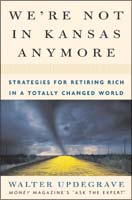Don't outlive your money
Mistake No.1: You haven't considered how long you'll be around.
NEW YORK (CNN/Money) - When you're accumulating money for retirement, you're probably aware that you're taking on investment risk -- that is, exposing yourself to the possibility that your stocks, bonds and other investments might lose value. What many people don't recognize, however, is longevity risk.
This is the all too real possibility that you'll outlive your money -- that you may run through your retirement stash before you pass into the great beyond, leaving you to live out your golden years in a less than golden fashion. And even if you're aware of this risk, chances are you greatly underestimate it, much as investors misjudged investing risk back in the 1990s. One reason is that few of us have a real understanding of life expectancy statistics, especially as they relate to couples. One of the peculiarities of actuarial calculations is that the odds of at least one member of a couple being alive at some point in the future are higher than the odds of either person alone. While a 65-year-old man has a 30 percent chance of living to age 90 and a 65-year-old woman has a 41 percent chance of hitting that age, the odds are nearly 60 percent that at least one member of a male-female couple both age 65 will be around at 90. All of which is to say that unless you've got a fatal condition or you have reason to believe that you're genetically programmed for a short life, you should expect that your assets will have to last a good 25 to 35 years after you retire. This has some profound implications on a practical level. At the very least, it means that you've got to factor inflation into your withdrawal strategy. If you continue to withdraw the same dollar amount year after year from your portfolio, you will eventually lose substantial purchasing power. To be able to buy the same level of goods and services, you will have to increase the dollar amount you withdraw from your portfolio each year. How big an increase you need will depend, of course, on the rate of inflation. But even at modest levels of inflation, I think most people would be surprised at how much their withdrawals would have to increase. For example, if you begin withdrawing $40,000 a year from your portfolio at age 65 and inflation averages 2 percent a year -- lower than the average of 3 percent or so since the 1920s -- then by the time you're 85, you'd need to withdraw just over $59,000 just to stay even. By 95, you'd need to withdraw more than $72,000. And if inflation came in at its historical 3 percent average, your annual withdrawal would have to top $72,000 at 85 and over $97,000 by 95 -- more than twice as much as your original forty grand. |
| |||||||||||

